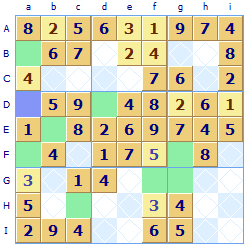
When checking for violations, if it is discovered that the "1" is not allowed, the value is advanced to "2". If there are no violations (checking row, column, and box constraints) then the algorithm advances to the next cell and places a "1" in that cell. Briefly, a program would solve a puzzle by placing the digit "1" in the first cell and checking if it is allowed to be there. Although it has been established that approximately 5.96 x 11 26 final grids exist, a brute force algorithm can be a practical method to solve Sudoku puzzles.Ī brute force algorithm visits the empty cells in some order, filling in digits sequentially, or backtracking when the number is found to be not valid. Backtracking is a depth-first search (in contrast to a breadth-first search), because it will completely explore one branch to a possible solution before moving to another branch. Some hobbyists have developed computer programs that will solve Sudoku puzzles using a backtracking algorithm, which is a type of brute force search. A Sudoku designed to work against the brute force algorithm. Each cell is tested for a valid number, moving "back" when there is a violation, and moving forward again until the puzzle is solved. Mathematical and Computational Algorithms Backtracking A Sudoku (top) being solved by backtracking. Although some niche communities also exist around trying to find the hardest possible puzzles. In general, puzzle makers aim to strike a balance between challenging the player while maintaining the puzzle fun to solve.
#Strategies for solving sudoku trial#
Most published sudoku puzzles of varying difficulties are purposefully constructed to be solvable by a human with pencil and paper techniques, even though it is easier computationally to construct a puzzle without checking if it requires trial and error to solve. There are several computer algorithms that will solve 9×9 puzzles ( n=9) in fractions of a second, but combinatorial explosion occurs as n increases, creating limits to the properties of Sudokus that can be constructed, analyzed, and solved as n increases. Players and investigators use a wide range of techniques to solve Sudokus, study their properties, and make new puzzles, including finding ones with interesting symmetries or other properties. Proper Sudokus have only one unique solution.

A Sudoku starts with some cells containing numbers ( clues), and the goal is to solve the remaining cells. Each cell may contain a number from 1 to 9, and each number can only occur once in each row, column, and box. Right angles give you a lot of information regarding the empty columns and rows in the cell they’re in, which can help you cancel out incorrect candidates in the adjacent cells.Algorithms to complete a sudoku A typical Sudoku puzzleĪ standard Sudoku puzzle contains 81 cells in a 9×9 grid, further subdivided into 9 separate boxes of 3×3 cells each.

Skyscrapers (two rows or columns of a given candidate that are unequal in length).

Revisit these regularly to make sure you don’t provide a false solution. Corner patterns help eliminate a ton of potential candidates in the rows and columns connected to it. Corners (a collection of 4 solved squares in any of the 4 corners).X Research source A few common patterns include: There are a bunch of different patterns out there, but if you can spot one, they’ll typically help you solve some element of the puzzle that you’re struggling with. Patterns refer to configurations of solved squares that help players regularly solve a sequence of candidates. There are a handful of patterns most players look for at this point.


 0 kommentar(er)
0 kommentar(er)
